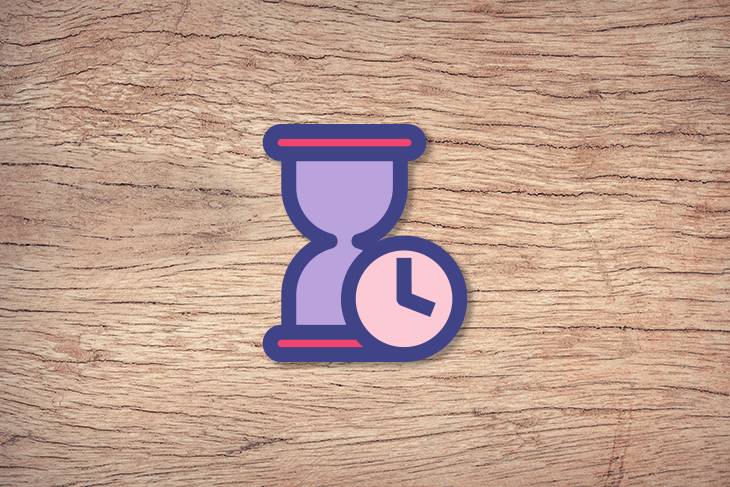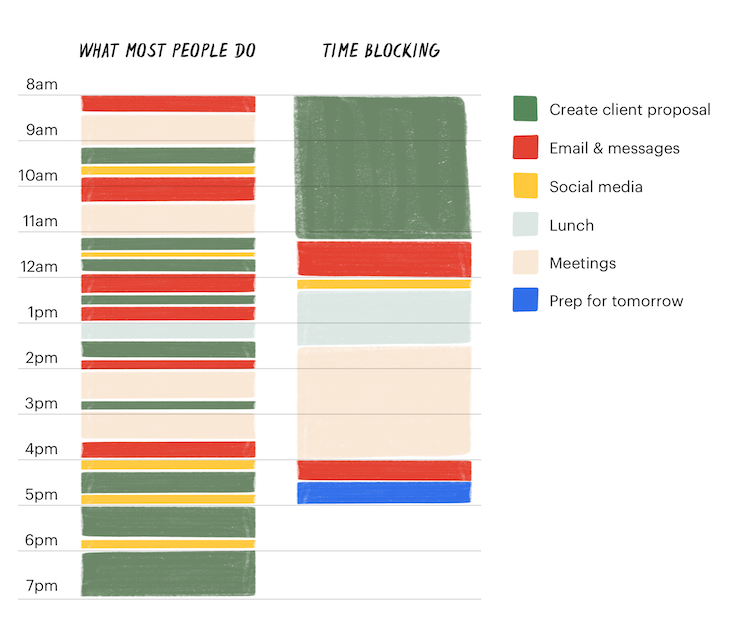Have you ever seen a product manager who can complete everything on their daily checklist?

Neither have I.
One of the most stressful factors of the job, and also one of the leading causes of impostor syndrome amongst PMs, is the fact that there are always more things to do than there are hours in a workday.
That’s why productivity and workload optimizations are crucial for product managers. Knowing that you’ve accomplished most of your weekly goals gives the much-needed mental comfort that PMs often lack.
There are various approaches to maximizing daily productivity. In this guide, we’ll cover time blocking.
Those who have either worked as a product manager or seen one in action know what I’m talking about: a PM’s work day is messy.
Not only is it packed with various, completely different activities — from status updates to design reviews to strategic planning — but these are often also highly unpredictable. You can’t forecast when another production issue or “urgent stakeholder request” will come your way.
Although it’s very unlikely to avoid messy work days altogether, building products is a chaotic and unpredictable endeavor. There are a few tactics to make the work more manageable and efficient.
One of these tactics is time blocking.
Time blocking is an approach where you do similarly themed tasks in a predefined slot rather than having it scattered throughout the week.

The primary goal of time blocking is to limit context-switching as much as possible, which increases your overall productivity.
It can be either recurring (for example, dedicating each Monday morning for status updates) or ad hoc (for example, clearing up to-do list from all design-related tasks).
There are plenty of reasons why time blocking is so effective.
Most notably, time blocking helps you:
The primary and most apparent benefit of time blocking is reduced context switching.
You don’t have to work only on one specific task during your time block. As long as you work on similarly themed tasks, you will notice it’s easier to move swiftly from one to another.
The transitions are so swift because you don’t have to completely switch contexts all the time. If you block off time to write various status updates, your way of thinking is already focused on writing updates, even if these are for different initiatives.
If you leave empty hours in your calendar to work on various tasks or create an available slot titled “general work”, you are asking for people to pull you into an unplanned meeting.
On the other hand, if you block the time off your calendar for a particular set of activities, an unplanned meeting will become less likely since it’s rude to throw you an overlapping invitation for the same time.
Just take a look at the example.

Who do you think is getting an unplanned meeting today?
You don’t know how much time you spend writing status updates, sending emails, or managing the roadmap until you start tracking it.
When you work on an adhoc basis, it’s nearly impossible to assess where your time goes. But, if you start using time blocks, and over time you adjust the length of these blocks to match the actual demand, you get a transparent picture of your time.
It then creates a powerful artifact to inspect and adapt. You might be surprised that you spend as many as 10 hours a week writing updates while spending as little as three hours managing the roadmap.
You might feel like you have your priorities right, but it’s a gut feeling unless you track your time diligently. Get some precision in assessing where your time goes. It’ll pay off.
When you block off a chunk of time, avoid multitasking, and protect yourself from distractions, your productivity will skyrocket.
In two hours of themed, distraction-free work, you can achieve much more than if it was four hours of unplanned, distracted work.
There is no silver-bullet approach to implementing time blocking, and different techniques will work better for different people. However, to give you a starting point, here’s how I’d approach implementing time blocking if I had to start from scratch:
The very first step is to identify your recurring tasks. What type of work repeats daily or weekly? What’s just unavoidable in your weekly schedule? Common activities include:
List out all of the activities that you know will repeat regularly.
Time blocking is most effective when it’s planned following one’s natural day cycle. We all have peaks and dips of productivity throughout the day. It would be a waste of time to block your most productive hour to answer emails, or to try to do your most demanding tasks during your least productive time of the day.
You can try daily journaling. Every hour, note down your energy level in the journal and repeat the process until you start to see patterns.
Now that you have a list of “themes” you work on regularly as well as an understanding of your productivity throughout the day/week, it’s time to plan out the week ahead.
Don’t try to plan out everything all at once, though. If time blocking is a new concept in your calendar, trying to “master it” in one go is a surefire way to failure and discouragement.
I also wouldn’t recommend changing the meeting schedule too much just yet. Try to use the capacity you currently have. Finding one hour each day to batch some work seems like a good start.
Once you start your journey with time blocking, you should inspect its effects and adapt your approach regularly.
Some tasks will take longer than you planned, and some shorter. Some slots might work better for you. Some may not work very well at all.
As you get better at time blocking, you might try reorganizing your meetings and modifying your calendar altogether.
Since the product manager’s job evolves and changes all the time, this step is also relevant all the time.
I’d recommend reviewing the approach weekly when you first start trying it out and at least once a month once you have the hang of it.
You should be wary of a few common pitfalls in implementing time blocking.
Some of these pitfalls include:
As tempting as scheduling your whole day with productive time blocks might be, it’s counterproductive at best.
You need breaks to go through the day, and don’t be afraid to block those out too! Not only do they help you recharge and be more efficient throughout the day, but they also give you some space for creativity.
After all, the best ideas happen under the proverbial shower.
Unexpected things will happen, and interruptions will appear. Don’t fight it. Accept it as a fact of life.
Booking the whole week without room for unplanned meetings and activities is just wishful thinking. The goal of time blocking and time management is to protect most of your time but never 100 percent of it. PMs must be flexible and react quickly to unexpected changes.
Leave some slots empty, or find a creative way to block out sections for “unplanned work.” Not only does this help you be more realistic, it can also cue your coworkers on times where they can ping you.
We both know there’ll be ad hoc interruptions during the week. Plan for them.
Some people like to turn everything upside-down whenever they discover a new time management approach. They get excited by the new technique and want to reap the benefits of it as soon as possible.
Big shifts rarely work. They often cause havoc without an immediate positive return. Take your time. Learn what works best for you, and adapt the approach so it best suits you.
Time blocking is a powerful productivity tactic that can help product managers achieve more throughout the week by limiting distractions and eliminating context switching. The general idea is to focus on a similar type of task for a prolonged period.
There are numerous ways to implement time blocking. One way is to start by identifying recurring tasks you often have, planning them around your highest and lowest productivity hours, and constantly inspecting and adapting.
Although the concept is relatively straightforward, there are some potential pitfalls to avoid. Make sure you still leave some slack in your calendar for unexpected tasks, don’t neglect the time for breaks, and, most importantly, don’t try to revolutionize your calendar from day one. Baby steps.
Featured image source: IconScout
LogRocket identifies friction points in the user experience so you can make informed decisions about product and design changes that must happen to hit your goals.
With LogRocket, you can understand the scope of the issues affecting your product and prioritize the changes that need to be made. LogRocket simplifies workflows by allowing Engineering, Product, UX, and Design teams to work from the same data as you, eliminating any confusion about what needs to be done.
Get your teams on the same page — try LogRocket today.

Trey Courtney talks about his process for evaluating partnerships or acquisitions and how he successfully implements these initiatives.

Asma Syeda shares the importance of responsible AI and best practices for companies to ensure their AI technology remains ethical.

What hard skills do PMs need in 2025? Learn how AI tools can help you level up in SQL, Figma, A/B testing, and more.

Paul Weston talks about “quantifying the unquantifiable,” i.e., bringing in objective data for things that otherwise seem hard to measure.